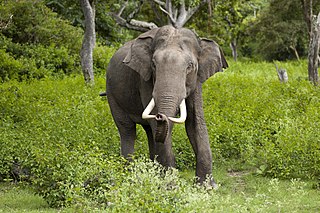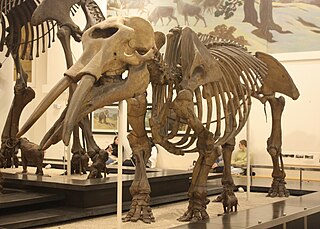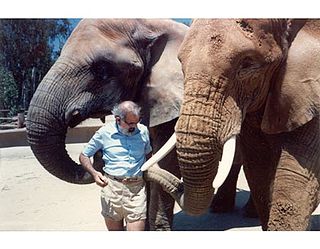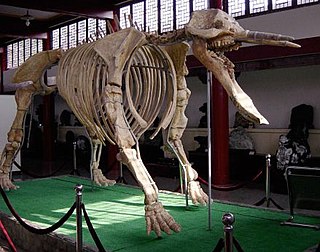
Proboscidea is a taxonomic order of afrotherian mammals containing one living family (Elephantidae) and several extinct families. First described by J. Illiger in 1811, it encompasses the elephants and their close relatives. Three species of elephant are currently recognised: the African bush elephant, the African forest elephant, and the Asian elephant.

A mastodon is a member of the genus Mammut, which, strictly defined, was endemic to North America and lived from the late Miocene to the early Holocene. Mastodons belong to the order Proboscidea, the same order as elephants and mammoths. Mammut is the type genus of the extinct family Mammutidae, which diverged from the ancestors of modern elephants at least 27–25 million years ago, during the Oligocene.

Elephantidae is a family of large, herbivorous proboscidean mammals collectively called elephants and mammoths. These are large terrestrial mammals with a snout modified into a trunk and teeth modified into tusks. Most genera and species in the family are extinct. Only two genera, Loxodonta and Elephas, are living.

Mammutidae is an extinct family of proboscideans belonging to Elephantimorpha. It is best known for the mastodons, which inhabited North America from the Late Miocene until their extinction at beginning of the Holocene, around 11,000 years ago. The earliest fossils of the group are known from the Late Oligocene of Africa, around 24 million years ago, and fossils of the group have also been found across Eurasia. The name "mastodon" derives from Greek, μαστός "nipple" and ὀδούς "tooth", referring to their characteristic teeth.

Amebelodon is a genus of extinct proboscidean belonging to Amebelodontidae. The most striking attribute of this animal is its lower tusks, which are narrow, elongated, and distinctly flattened with the degree of flattening varying among the different species. One valid species is known for this genus, which was endemic to North America. Other species once assigned to Amebelodon are now assigned to the genus Konobelodon, which was once a subgenus.

Gomphotheres are an extinct group of proboscideans related to modern elephants, widespread across Afro-Eurasia and North America during the Miocene and Pliocene epochs and dispersed into South America during the Pleistocene as part of the Great American Interchange. Gomphotheres are a paraphyletic group ancestral to Elephantidae, which contains modern elephants, as well as Stegodontidae.

Gomphotherium is an extinct genus of gomphothere proboscidean from the Neogene of Eurasia, Africa and North America. It is the most diverse genus of gompothere, with over a dozen valid species. The genus is probably paraphyletic.

Anancus is an extinct genus of "tetralophodont gomphothere" native to Afro-Eurasia, that lived from the Tortonian stage of the late Miocene until its extinction during the Early Pleistocene, roughly from 8.5–2 million years ago.

Stegotetrabelodon is an extinct genus of primitive elephantid from the Late Miocene to Early Pliocene of Africa, the Arabian Peninsula, and Italy.

Jeheskel "Hezy" Shoshani was an evolutionary biologist who studied elephants and their relatives for over 35 years.

Tetralophodon is an extinct genus of "tetralophodont gomphothere" belonging to the superfamily Elephantoidea, known from the Miocene of Afro-Eurasia.

Eubelodon is an extinct genus of gomphothere which lived in North America during the Miocene Epoch. It contains a single species: Eubelodon morrilli.

Zygolophodon is an extinct genus of mammutid proboscidean that lived during the Miocene in Africa, Eurasia, and North America.

Stegodontidae is an extinct family of proboscideans from Africa and Asia from the Early Miocene to the Late Pleistocene. It contains two genera, the earlier Stegolophodon, known from the Miocene of Asia and the later Stegodon, from the Late Miocene to Late Pleistocene of Africa and Asia which is thought to have evolved from the former. The group is noted for their plate-like lophs on their teeth, which are similar to elephants and different from those of other extinct proboscideans like gomphotheres and mammutids, with both groups having a proal jaw movement utilizing forward strokes of the lower jaw. These similarities with modern elephants were probably convergently evolved. Like elephantids, stegodontids are thought to have evolved from gomphothere ancestors.

Konobelodon is an extinct genus of amebelodont proboscidean from the Miocene of Africa, Eurasia and North America.

Amebelodontidae is an extinct family of large herbivorous proboscidean mammals related to elephants. They were formerly assigned to Gomphotheriidae, but recent authors consider them a distinct family. They are distinguished from other proboscideans by having flattened lower tusks and very elongate mandibular symphysis. The lower tusks could grow to considerable size, with those of Konobelodon reaching 1.61 metres (5.3 ft) in length. Their molar teeth are typically trilophodont, and possessed posttrite conules. In the past, amebelodonts' shovel-like mandibular tusks led to them being portrayed scooping up water plants, however, dental microwear suggests that they were browsers and mixed feeders. The lower tusks have been proposed to have had a variety of functions depending on the species, including stripping bark, cutting through vegetation, as well as possibly digging. They first appeared in Africa during the Early Miocene, and subsequently dispersed into Eurasia and then North America. They became extinct by the beginning of the Pliocene. While some phylogenetic studies have recovered Amebelodontidae as a monophyletic group that forms the sister group to Gomphotheriidae proper, some authors have argued that Amebelodontidae may be polyphyletic, with it being suggested that the shovel-tusked condition arose several times independently within Gomphotheriidae, thus rendering the family invalid.

Eozygodon is an extinct genus of proboscidean in the family Mammutidae that is based on a single species, E. morotoensis, named in 1983. It is known from the Early Miocene of Africa and well as possibly the Middle Miocene of China. It is considered a primitive member of the family, retaining a long lower jaw (longirostrine) with lower tusks. The upper tusks are small, and are parallel to each other. The skull of the young adult AM 02 from Auchas, Namibia, was around the size of that of a 10 year old American mastodon, around 60 centimetres (2.0 ft) in maximum length. Dental mesowear from East African specimens suggests a browsing diet. Some authors suggest that Eozygodon could be less closely related to other members of Mammutidae than other mammutids are to Elephantida, making Mammutidae as typically defined paraphyletic.

Torynobelodon was a genus of large herbivorous mammal related to the elephant. It lived during the late Miocene Epoch in Asia and North America.

Pediolophodon is an extinct gomphotheriid proboscidean genus from the middle to late Miocene of North America. Pediolophodon was a close relative of elephants and would have appeared superficially similar to them, but was not itself a true elephant.
Eurybelodon is an extinct genus of proboscidean in the family Amebelodontidae. It lived in the Clarendonian age of the Miocene.




















